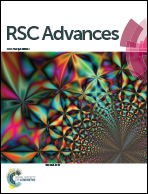Synthesis of photocatalytic hematite nanotube array using a template-free solvothermal approach
Abstract
The paper describes a template-free solvothermal synthesis of α-Fe2O3 hollow nanotube arrays over a large area. The columnar nanotubes on the substrate have closed tips and smooth defined walls. The thickness of the nanowall is about 10 nm, which could offer short diffusion distances and decrease recombination of electron–hole pairs. And the preferential orientation is the [110] axis. The cubic Au nanocrystals were decorated by a photocatalytic reduction process, and the corresponding EDX mappings intuitively display the distributions of the composites. Au nanocrystals matched the absorption of α-Fe2O3 hollow nanotube arrays, which improved photoactivity under visible light (wavelength > 420 nm). The photoactivity of the sample was investigated based on systematic photoelectrochemical (PEC) measurements. These revealed that the photocurrent density of Au/α-Fe2O3 is almost 6 times higher than that of pure α-Fe2O3. And its photocurrent density increases to 0.16 mA cm−2 at 1.23 VRHE under irradiation. The mechanism of enhanced visible light PEC activity has been discussed using schematics. Hence, the study presents not only a route for formation of α-Fe2O3 hollow nanotube arrays but also PEC applications of plasmonic composites.


 Please wait while we load your content...
Please wait while we load your content...